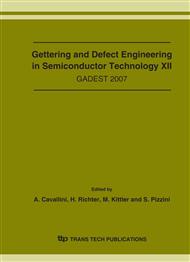p.393
p.399
p.405
p.413
p.419
p.425
p.431
p.437
p.443
Impact of Extended Defects on the Electrical Properties of Solar Grade Multicrystalline Silicon for Solar Cell Application
Abstract:
Aim of this work is to study the electrical properties and the minority charge carrier recombination behaviour of extended defects in multicrystalline silicon (mc-Si) ingots grown from solar grade silicon (SoG-Si) feedstock. The pure metallurgical SoG-Si feedstock has been produced directly by carbothermic reduction of very pure quartz and carbon without subsequent purification processes.This mc SoG-Si is studied by temperature-dependent Electron Beam Induced Current measurements and PhotoLuminescence spectroscopy and the potentiality of the combination of these two techniques in the identification of the defects which limit the quality of the base material is shown. The EBIC mapping technique shows the presence of electrically active grain boundaries at room temperature while dislocations result inactive. Dislocations become active only at temperatures lower than 250K, indicating a moderate level of metal decoration. The most detrimental defects in this material seem to be the grain boundaries and impurities dissolved in the matrix. Furthermore, the PL spectra reveal the presence of oxygen and carbon related complexes. In this work we show that the knowledge about the defect related recombination processes acquired by a combined application of EBIC measurements and PL-spectroscopy is of particular importance to tune the proper solar cell process step to be applied on such material.
Info:
Periodical:
Pages:
419-424
Citation:
Online since:
October 2007
Authors:
Keywords:
Price:
Сopyright:
© 2008 Trans Tech Publications Ltd. All Rights Reserved
Share:
Citation:


